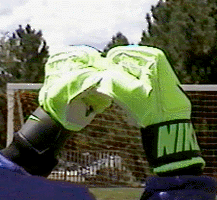Punching, or boxing, is used to clear away crossed balls that cannot be caught, usually in heavy traffic. It is not a technique used often, as the ball should be caught whenever possible, but can be very effective in allowing a keeper to demonstrate they have complete control over their goal area. If there is any doubt for a keeper that they they will not be able to catch a cross, it should be punched. "When in doubt, punch it out" (but remember this applies only to crosses, not shots!). The proper hand position for punching is important for best control and for avoiding finger injuries. The hands should form a fist, with the four fingers forming a flat surface, and the thumb pressed firmly against the side of the fist but below the flat surface out of harm's way. The flat surface allows for the most control, as well as getting sensitive knuckles out of the way. Do not tuck the thumb inside the fingers, as this is just asking for a hand injury. Punching can be done with one hand or both hands. This is determined by the direction you want the ball to go: If you are trying to send the ball back in the direction it is coming from, use two hands. If you want the ball to continue away in the same direction it is already going, use a one-handed punch. A two-handed punch starts with the fists placed together to form the largest surface possible. The hands should start close to the body, elbows at the sides, and then explode through the ball, utilizing back and hip muscles as well, to drive the ball high, far and wide of the goal. Often a weak punch results when the ball is struck with arms already extended, so make sure the hands start from close to the body. The hand takes the same shape for a one-handed punch as for a two-handed punch; use the flat surface formed by the fingers. Use a one handed punch to box the ball in the same direction it is already going: use the arm on the same side the ball is coming from, and punch in a powerful, compact motion across the body to send the ball on. Avoid a wide, looping swing as this does not generate much power. This should be a punch, not a slap!
The three keys to an effective punch are:
Punching hand position
Sunday, October 4, 2009
Punching
Posted by Syarif at 4:41 AM
Subscribe to:
Post Comments (Atom)
0 comments:
Post a Comment